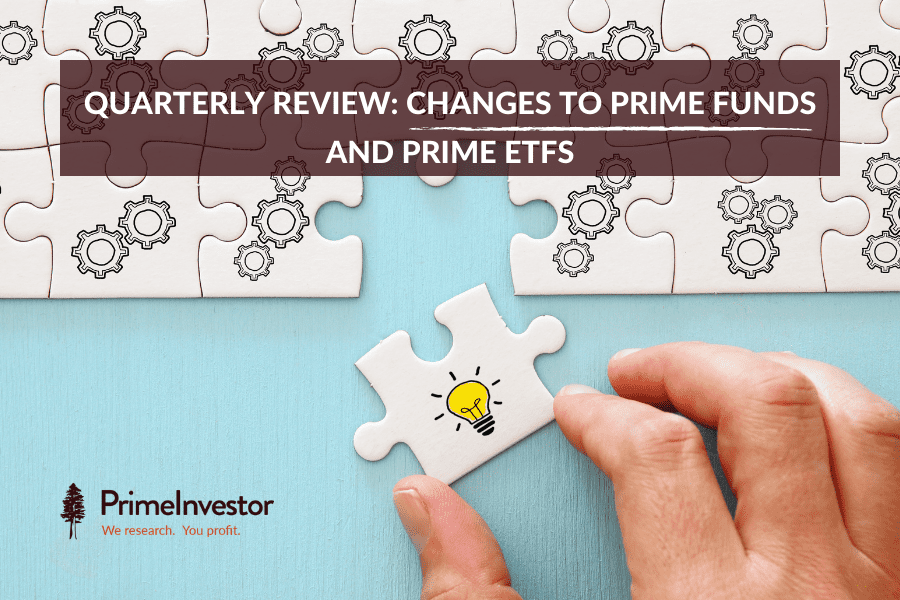Many of you ask us why we churn funds in our Prime Funds (our list of recommended funds). But we don’t really churn much! We try and add newer and better funds when we identify them. It does not necessarily mean you have to add them too, if you already hold other funds.
It also does not always mean that every fund we remove is bad. Sometimes, we simply mean that there are better ones now for newer investments. At other times it might be that some funds need watching and it is safer to stop SIPs and hold them for now. In extreme cases, where performance shows few signs of turnaround, we give a sell. We state each of this call-to-action clearly and request you to go through them carefully in our quarterly reviews.

When we reviewed Prime Funds for the just-ended June quarter, we did not worry about funds with performance issues linked to the market as there has been a market rout. But where funds that were already showing signs of underperformance cracked further and could not contain downside (which is a key criterion we look for) in this fall, we did not take to it too kindly.
We have only a few changes this quarter with some interesting additions in the equity aggressive category and in debt as well. We have also added a couple of themed funds to capture a visible up trend in the economic activity.
About Prime Funds
New to PrimeInvestor? This is what you need to know about Prime Funds:
Prime Funds is our list of best mutual funds across the equity, debt, and hybrid categories. We use Prime Ratings, our fund ratings, as a first filter. We then apply qualitative analysis to arrive at our fund recommendations. Prime Funds is an enduring list of funds that you can use at any time and you will find a fund that meets any goal you’re looking to meet.
Different categories: Prime Funds are separated into buckets, based on risk level in equity & hybrid funds and timeframe in debt funds. Each of these draws from different SEBI-defined categories. We have classified them in a more user-friendly way than using the several dozens of SEBI categories. We do not go only by Prime Ratings but look at other factors as well to narrow the list and make the choices easy for you.
Different styles: In Prime Funds, we’ve aimed at providing funds that follow different strategies for you to mix styles and diversify your portfolio with ease. The ‘Why this fund’ for each Prime Fund will brief its strategy, why we picked it, and how to use it in your portfolio.
Direct plans: We have specifically given the direct plans in Prime Funds. If you wish to know whether it is ok for you to use the regular plan of the fund, check our MF Review Tool (not our Ratings). If the review specifies ‘buy through direct,’ it means that the expense ratio differential is high under the regular plan for that fund. You will be better off using the direct plan in such cases. You can also check the expense ratio differential using our expense ratio tool.
Quarterly review: Our aim in reviewing the Prime Funds list every quarter is to ensure that we don’t miss any good opportunities that are coming up and we are not holding on to funds that are slipping. When we remove funds from the Prime Funds list, we tell you exactly what to do if you have invested in these funds. Funds we remove do not immediately call for a sell – it is just that they have slipped in performance marginally or there are better alternatives now. Unless our review tool says such funds are a ‘sell’, you can hold them (refer to our article on when to sell funds)
Using Prime Funds: You don’t need to hold every Prime Fund nor add any new fund we introduce to the list. Unless it fits your overall portfolio/strategy, or there is something lacking, there is little need for you to go on adding funds. Our idea of covering them in detail through some of our weekly calls is to let you know the strategy, style, and suitability in different portfolios. It is not a specific call to buy right away, unless we mention that it is a ‘tactical’ or ‘timing’ call.
Equity funds
The quarter ending June 2022 was not too kind to the stock markets locally and worldwide. In India, the Nifty 50 fell over 9% in the June quarter while the broader market, represented by the Nifty 500 fell a little more at 10%. The midcap index managed to hold its ground and was not worse off than the Nifty, but the Nifty Small Cap 100 fell over 18%, with some fancied stocks of the bull market taking a sharp hit.
Needless to say, its impact would have been felt in your portfolio. Funds too were not immune to the fall. We explain some of the impact of the fall on certain funds and also call out funds where we are making changes.
Equity – Moderate
Funds in this segment managed to contain downsides. A few that took a hit did so because of higher impact of the bear market in their individual stock picks. For example, Axis Bluechip’s underperformance can be traced to hits in IT stocks such as Infosys or financial stocks such as Bajaj Finance. These stocks took a harder hit; the fund’s higher exposure to these stocks, as it adopts a more focused portfolio approach, impacted performance. This fund continues to be in our list. We will watch for performance. There are no other changes in this segment.
Equity – Aggressive
After a few quarters’ watching, we decided to remove DSP Midcap from our list of Prime Funds, given that the fund’s rolling 1-year return outperformance (over 3 years) is now below category average. The March quarter saw some improvement as markets picked up then but the correction once again has made it difficult for the fund to make a swift comeback. This rolling return underperformance since October 2021 puts it in the backseat now in terms of competing with peers especially in this market. You can stop fresh investments and SIPs in this fund and hold existing investments. We will alert you if there is a change in our stance. You can also check our MF review tool every quarter for this.
We removed Axis Small Cap mid cycle in May 2022, when allegations of front running were made against two fund managers who managed some of the schemes. We have explained the changes we made, here. We added Nippon India Small Cap to our ready-to-use portfolios in place of Axis Small Cap.
We are now adding the fund to Prime Funds as well. Nippon India Small Cap is among the few funds that has managed performance in the small-cap space despite high AUM. It has managed this with a large number of stocks with limited exposure to each. This fund is suitable only for high-risk investors as it does not provide much downside protection and tends to fall higher than the category average in bear markets. It is best invested through SIPs.
With the market correction, we thought adding another aggressive fund will help now. Accordingly, we added PGIM India Midcap Opportunities Fund. Apart from showcasing very high consistency in outperformance over 1- and 3-year rolling periods, we like its portfolio. Current exposure, specifically to quality capital goods and automobile stocks, provides scope for delivering returns given the increased economic activity. You can consider some lumpsum followed by SIPs, if you plan to invest now. But make sure that exposure is limited to less than 5% of your portfolio as this fund house is yet to gather a track record.
Other than the above changes, we observed underperformance in UTI Flexicap on account of its heavy exposure to financials and technology. These sectors were hit hard in the last quarter’s correction. The fund’s rolling return record still remains above peers and does not show much concern. We will wait to see how the fund recovers when key sector holdings recover.
Equity – tax-saving
In this review, we removed Axis Long Term Equity from Prime Funds on account of underperformance over the past 6 months on a rolling 1-year return basis. The underperformance widened in this market correction. This fund too, like the Axis large cap fund, held heavy exposure to stocks such as Bajaj Finance that took a beating. But unlike that fund, Axis Long Term Equity’s underperformance over the Nifty 500 is on the higher side. We decided to therefore remove it from our Prime list and watch it for now. You can hold the fund but consider the two other options in our list for any fresh investments.
Equity – thematic
In this category, we have removed ICICI Pru Commodities. We added this fund in March 2021, to take advantage of the global upswing in commodity prices. This call has paid off well since then. In the past month, as commodity prices began cooling off, we gave a book profit on this equity fund to realise the gains. At the time, we still held the fund in Prime Funds. However, there has since been a further correction in commodity prices in the face of a global economic pull back. Our own government is also actively trying to reduce prices through duties and other moves.
Therefore, we are removing the fund from our recommendation list to avoid fresh investments in the theme. Continue to hold investments made. We still like the overall portfolio moves that the fund has made in terms of sector allocations, and a robust domestic growth can support earnings and stock prices. Please read our earlier report (linked above) on the fund for more details.
We have added Kotak Manufacture in India fund in this review. Economic activity is picking up in the post-Covid opening up, and indicators such as core sector growth, company capex plans, order books for capital goods and infrastructure players, increased freight activity and so on have been pointing to a revival in the broader economy. To play this revival, the manufacturing theme fits well as it invests across core economy segments and across market capitalisations.
The Kotak fund is a new one, having been launched in February 2022. Our call is based on the potential in its portfolio and not past performance. It holds a large portfolio featuring wide diversity in sectors, while other funds in the same theme are narrower in sector allocations.
We had also added UTI Transportation & Logistics to Prime Funds earlier in June, when we gave an invest recommendation on the fund based on the recovery in the auto space. As always, thematic funds are high-risk. Cap portfolio allocations to themes/sector funds to about 15% of your portfolio.
A summary of the changes we made to the equity section of Prime Funds in this review is captured in the tables below.
Hybrid funds
Hybrid equity – moderate risk
In this category, we have added ICICI Prudential Equity & Debt. The fund was earlier part of Prime Funds; we had removed it in our September 2020 review owing to its prolonged severe underperformance. We had maintained a Hold on the fund as it otherwise had always been consistent performer.
The fund has turned its portfolio around and begun doing better than the Nifty 50 Hybrid Composite 65:35 index from about mid last year. The improvement has been gradual and steady. Therefore, we have added the fund back to the Prime Funds list. Note that the fund still remains low on most quantitative metrics due to its past poor performance which reflects in its Prime Ratings. Our call is based on the improvement we’re seeing against benchmark and category, its portfolio, and earlier pedigree.
A summary of the changes made to the hybrid section of Prime Funds is captured in the table below.
Debt funds
The debt space is finally setting up for better yields after a prolonged period of low interest rates. Portfolio YTMs have started to inch higher. Of course, the transition of higher interest rates in portfolios and performance will depend on the fund type. But you can look forward to debt returns gradually improving.
Meanwhile, due to the rate hikes and correction in bond prices, target maturity funds currently sport attractive yields. To capture these tactical opportunities, we have included a couple of these in Prime Funds. For the funds we have added, the yields are favourable against comparable debt fund YTMs right now.
Debt funds will see YTMs slowly rise as they add higher-coupon instruments. But because target maturity funds allow you to lock into yields at the time of investment, they can offer a better return profile as long as their superior yields last. Therefore, these target maturity additions in Prime Funds will be a temporary one which we will remove based on yield and YTM movements.
These funds are best held till maturity so align your investment horizon with the fund’s maturity. If you have a longer horizon, you may be better off going for the other debt funds. Remember that target maturity funds will return your money to you once they mature.
Debt - Very short-term – 3 months to 1.5 years
In this category, we have removed Axis Treasury Advantage as it has seen AUM fall drastically. We had been watching developments in the fund’s AUM; we noted this in our January 2022 Prime Funds update. Though stabilizing for a while, AUM has since continued to fall and has more than halved to Rs 5,086 crore between July last year and now.
The AUM in absolute terms is still large. There are no risks as yet in the portfolio and performance still holds. However, the continuing drop is concerning. More decline is likely to give rise to risks – such as higher concentration in papers, liquidation pressures to meet redemptions especially by institutional investors, inability to deploy into papers with higher coupons as interest rates rise and so on. The governance issues in the AMC may also hurt. Therefore, we are taking a conservative stance to avoid any risks in short-term investments.
If the goal for which you have invested in the fund is less than a few months away, you may continue to hold until you need the money. Else, it is best to exit and reinvest in the debt fund from Prime Funds that suits your purpose. Stop any SIPs.
In this category, we are adding a target maturity fund – the Bharat Bond FoF April 2023, a passive debt index fund that comprises AAA-rated PSU bonds with underlying maturity in 2023. The yield on this index, at 6.1%, is attractive now compared to other very short-maturity debt funds as well as bank deposits. The fund is suitable for those looking for a low-risk, predictable debt option.
Debt - Short-term –1.5 to 3 years
In this category, we added another target maturity fund – the Bharat Bond FoF April 2025, a passive debt index fund investing in AAA-rated PSU bonds with underlying maturity in 2025. At 7.1%, its yields currently hold better than most short-duration funds. The fund is suitable for those looking for a low-risk, predictable debt option.
Debt - Medium-term – 3 to 5 years
We have not made any changes in this category. We’d however like to explain the performance of HDFC Corporate Bond (also part of the Debt Long-term Prime Funds category) which has returned relatively poorly. This is attributable to the longer maturity profile that this fund holds.
The fund also has a good 27% of its portfolio in gilt instruments; this could be on account of the healthy yields that these instruments are offering now which can bring in accrual income. However, these bonds are now in correction-mode due to the rate hikes. We are not worried about the fund’s performance and it can tide over this low-return period in due time. It remains a good bet for those with a timeframe of at least 3 years. Continue with SIPs, if any.
Debt – Long term – above 5 years
Here too, there are no changes. As above, we’d like to take note of SBI Magnum Constant Maturity. The fund’s returns have shrunk as longer-term gilt prices corrected in reaction to rising rates. Because the fund needs to maintain an average 10-year maturity, it cannot cut down to the low-volatile short-term gilt space as other gilt funds can and have done. However, we still prefer a constant maturity play in the gilt space as it limits the risk of a fund mistiming its maturity calls which can impact return. Please read a more detailed explanation on the fund in this report, including why it remains a good investment especially at this time.
A summary of the changes made to the debt section of Prime Funds is captured in the tables below.
Prime ETFs
Equity - Moderate risk
We added HDFC S&P BSE Sensex ETF to our list of moderate risk ETFs. This is among the few viable ETFs to track the Sensex index as most ETFs with healthy liquidity are based on the NSE indices. It sports a low tracking error in both short-term and long-term periods. It has a marginally lower expense ratio than other Sensex ETFs. While this ETF’s trading volumes are not as high as Nifty ETFs, volumes are still reasonable. This is suitable for the core of your portfolio. You need not hold this ETF if you already hold the Nifty ETF.
Equity – Strategy & thematic
We have not made any changes here. We would like to alert you on the NAV and market price deviation prevailing in Motilal Oswal Nasdaq 100 ETF on account of the restrictions placed by RBI. While this ETF continues in our list, if you are comfortable using the fund route, go with our Prime Fund recommendation of Kotak Naasdaq 100 FoF if you wish to invest in the Nasdaq 100 index. You can hold existing investments in the Motilal ETF as the deviation only makes the market price return higher.
Debt & Gold
We added Bharat Bond ETF – April 2025 – a target maturity fund - on account of the attractive yields prevailing now. At 7.1%, its yields currently hold better than most short-duration funds. The fund is suitable for those looking for a low-risk, predictable debt option and is best held till maturity. Please note that this will mature in April 2025. Loaded with PSUs, it does not sport any credit risk.
A summary of the changes made in Prime ETFs is captured in the table below.




2 thoughts on “Quarterly review – changes to recommendations in Prime Funds & Prime ETFs”
Hi,
Last year prime funds were given in a PDF format , does it exists today for the prime subscriber?
Thanks
Siva
We do not give the full Prime Funds list in PDF format. Please go to Prime Funds on our platform for our fund recommendations. – thanks, Bhavana
Comments are closed.